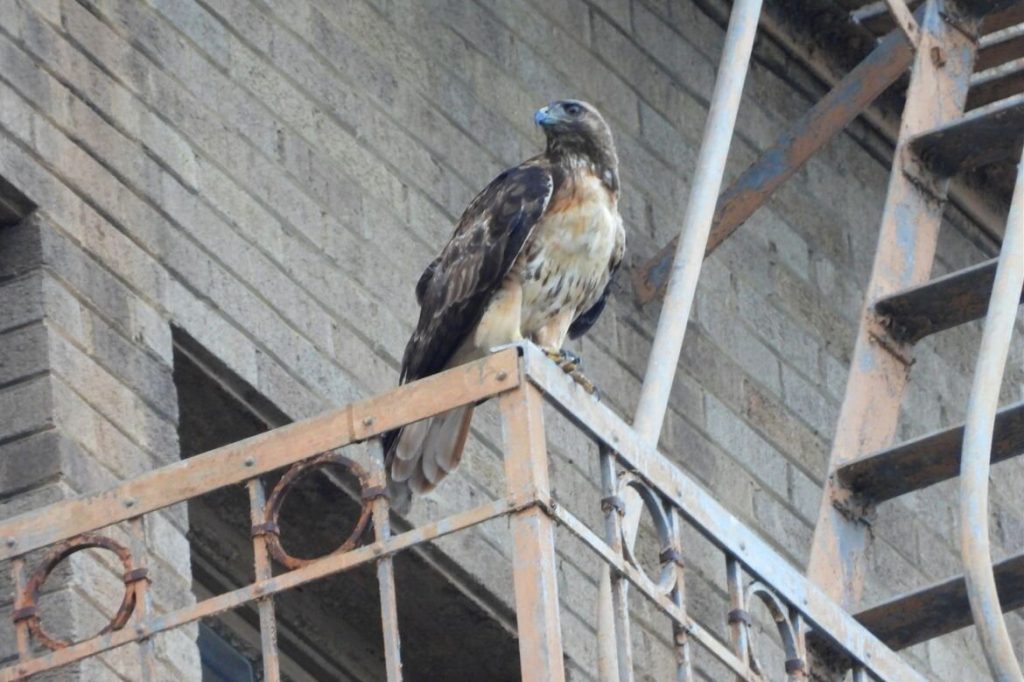A red-tailed hawk in the Koreatown section of Los Angeles. A UCLA-led study concluded that there would be dramatic loss of diversity among bird species unless there are practical plans to preserve it. Credit: Nurit Katz/UCLA
As cities gobble up natural spaces, some birds have learned to live alongside skyscrapers, traffic and noise—and large numbers of humans.
A UCLA-led team of biologists wondered if those city-dwelling birds share common characteristics around the world that help them survive. In a paper published in Current Biology, they reveal the answer: Urban bird species tend to be smaller and less territorial and have greater ability to fly long distances. They also tend to have broader dietary and habitat niches, to lay more eggs at a time, to have longer lifespans and to live at a wider range of elevations than other species.
Several factors moderate the importance of those traits in how birds adapt to urban living, and the importance of those traits varies predictably across the planet.
The only trait that didn’t appear to be consistent globally among urban-dwelling birds, the researchers found, was the shape of their bills.
By 2030, the paper notes, the amount of urban land cover worldwide will have grown by 1.2 million square kilometers (or more than 463,000 square miles) since 2000—roughly tripling over a 30-year period. That increase in urban space would be larger than the land area of California and Texas combined.
The authors write that a dramatic loss of biodiversity will accompany that urbanization unless there are practical plans to preserve it.
“Identifying traits that help wildlife adapt or even thrive in cities can help urban planners bolster biodiversity by, for example, increasing green spaces, planting more and taller trees, building more varied potential habitats, or reducing housing density,” said the paper’s lead author, Monte Neate-Clegg, a UCLA postdoctoral researcher. “It can also help conservation biologists to identify which types of species are most threatened by urbanization.”
Neate-Clegg and Morgan Tingley, a UCLA associate professor of ecology and evolutionary biology, combined data including records of more than 125 million individual bird sightings from the public science project eBird to calculate an “urban association index” that describes how closely each species is associated with living in urban settings.
They applied the measure to 3,768 bird species—around 35% of all bird species—in 137 cities across six continents.
The index takes into account factors like physical characteristics of the birds themselves and the geographic, population and landscape characteristics of the cities.
“Many of the most common urban birds globally are very familiar to us here in the U.S., including the house sparrow, barn swallow, osprey, and peregrine falcon,” Tingley said. “Although, interestingly, the species with the strongest associations with urban areas are actually three species of parakeet and a tanager from South America. Plus, of course, the feral pigeon.”
Interestingly, some of the species with the highest scores on the index—meaning that they were most closely associated with urban living—were not native to their regions, but such species made up less than 4% of the dataset, suggesting that invasive species might not have as big of an advantage as logic would suggest. Bird families with high average scores on the index—indicating that many species within that family were common in cities—included starlings, swifts, swallows, parrots, orioles and blackbirds.
Traits like smaller body size, lower territoriality, greater ability to fly longer distances—which scientists refer to as “dispersal ability”—broader dietary and habitat niches, larger clutch sizes, all tend to make it easier for city birds to find food and suitable nesting places, and to raise young that survive.
Bird species that generally build nests on the ground were not likely to live in cities, for fairly obvious reasons.
“In a city like Los Angeles, for example, the American crow is a cosmopolitan species whose broad diet, arboreal nesting habits and long lifespan favor life in the concrete jungle,” Neate-Clegg said. “In contrast, canyon wrens are highly territorial insectivores with low dispersal ability that shun cities and keep to steep, rocky terrain.”
But cities’ geographic properties—most notably their latitude—moderated the importance of those traits. For example, a broad diet was more important in temperate cities such as New York, while habitat generalists were more prevalent in tropical cities such as Bogotá, Colombia. The cities’ population sizes and surrounding terrain also played important roles: Anchorage, Alaska, with its small population and plentiful natural surroundings, is home to large birds like bald eagles that mostly feed on fish from rivers and lakes. Meanwhile, smaller birds that don’t require as much raw land and that can adapt to eating a variety of foods to survive would be more likely to inhabit sprawling, densely populated metropolises like Bangkok.
More information: Montague H.C. Neate-Clegg et al, Traits shaping urban tolerance in birds differ around the world, Current Biology (2023). DOI: 10.1016/j.cub.2023.03.024
Provided by University of California, Los Angeles
Citation: Study identifies traits that help birds adapt to urban living, shows better planning can bolster biodiversity (2023, May 3) retrieved 22 May 2023 from https://phys.org/news/2023-05-traits-birds-urban-bolster-biodiversity.html
This document is subject to copyright. Apart from any fair dealing for the purpose of private study or research, no part may be reproduced without the written permission. The content is provided for information purposes only.

